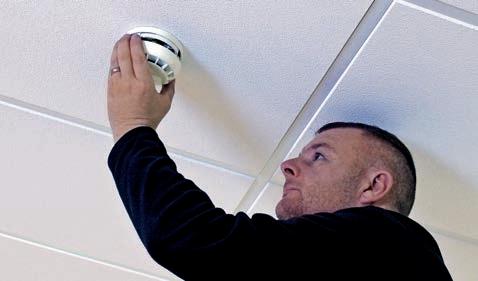SPECIAL FEATURE
FIRE, SAFETY & SECURITY
WHY FIRE SAFETY AND SECURITY MUST REMAIN A PRIORITY Since the Electrical Safety Standards in The Private Rented Sector (England) regulations came into force on 1 July of this year, focus has now turned to what this legislation will mean for the fire safety and electrical industry, writes Marc Gaunt, Category & Segment Marketing Manager, Eaton.
Marc Gaunt, Category & Segment Marketing Manager, Eaton
A
mongst other requirements, property owners must now have the electrical installations in their properties inspected and tested by a person who is qualified and competent, at least every five years. Whilst this is a step in the right direction, more can still be done to make sure suitable technology is fitted in the first place, to make safety and security a priority in buildings across the UK. Recent months have seen the global workforce adapting to remote working, and unsurprisingly, this has brought to light new challenges around fire safety and security standards. In 2020, there has been an increase in weekday fires in the home due to cooking, smoking, electrical items and heating sources being used more frequently, as people are spending more time indoors than usual. Yet, we should see this time of change as an opportunity for both businesses and individuals to upgrade fire and security protections in their premises. Every year, the cost of fire damages in Europe is around €126 billion (£114bn), and it is time for facilities managers and building owners to explore how technology can reduce these risks in residential and commercial buildings.
A collaborative approach to fire and security safety Whilst it often falls on electrical contractors to make buildings safe by ensuring they adhere to legislation put in place in the UK, new data also shows that fire and rescue services (FRS) are introducing training in line with the changing nature of risk today to help reduce harm. A freedom of information request earlier this year found 34 fire and rescue services up and down the country have gone as far as to introduce specific operational training to improve the response to rescuing individuals from buildings. They now also plan for newer threats such as terrorist attacks, in addition to more ‘traditional’ threats like fire and flooding. Whilst this is extremely positive, individuals’ safety within buildings cannot rely on fire brigades and electrical contractors alone – we must take a more collaborative, proactive approach to our safety.
42 | November 2020
Fire, Safety & Security – Eaton.indd 42
Building owners and facilities managers should understand the new risks to occupants and infrastructure in UK buildings today, as well as taking steps to mitigate these threats. Building and occupant safety is becoming more challenging as we face a number of non-traditional threats, from power outages to terrorism. The changing profile of risk today requires facilities managers to constantly re-evaluate safety strategies for those who use their premises. 2020 has seen thousands of employees move to remote working, allowing some commercial building owners the time to make major changes to the fire and safety procedures in their building. As 1.5 million SMEs in the UK do not have a business plan in place for improving fire safety in the long run, the next few months may be the perfect time for leaders to implement large-scale plans. Building owners and managers should assess the need to add features like new fire exits and upgrade security systems such as CCTV – and as workers continue to work remotely, these changes won’t cause disruption to a normal working day.
Technology has the potential to mitigate fire risk
Facilities managers and building owners must continually educate themselves on the newest technologies
In addition to new risks, more traditional threats remain just as prevalent – as of 2019, more than 25% of fires are caused by electrical failure. Data shows that almost a third (31%) of respondents reported an increase in primary fires in residential buildings ignited by an electric fault or caused by a problem with electrical distribution compared to five years ago. This leap in primary fires has also led to an increase in the number of people fire brigades have had to rescue from buildings due to electrically-ignited fires or fires stemming from electrical distribution compared to five years ago. In fact, 24% report an increase for these rescues from residential buildings and 26% confirm an increase from commercial buildings. The number of electrical devices in the home and at work has increased significantly as technology has advanced. While this may explain the increase in electrically-ignited fires, technology advances have also led to solutions which can mitigate the risks of these fires and offer better protection to individuals – whether they are on commercial or private premises.
electricalcontractingnews.com
Facilities managers and building owners must continually educate themselves on the newest technologies, from Arc Fault Detection Devices (AFDDs) that prevent electrical fires, to the latest adaptive evacuation technology which can ease congestion or help guide people safely out of a building when trying to evacuate. In addition to easing reliance on our fire and rescue services, this will improve building safety for everyone – whether that’s staff in an office, students within a university or sports fans in a stadium. It is true that the breadth and severity of safety risks in buildings is expanding. Safety is a key focus for facilities managers and building owners, but as they navigate this complicated threat landscape, it’s vital that they explore the technology that can reduce risks. Many electrically-ignited fires can be prevented before they start. Evacuation processes can be streamlined to get people to safety more quickly. This new era of risk requires new and forward-looking defence mechanisms. Without them, there is risk of failing to protect what matters most. Building owners and managers must re-evaluate the way they protect people and property in line with the changing nature of risk and risk mitigation today. Eaton, eaton.uk.com
@ElecConNews
/electricalcontractingnews
15/10/2020 15:33
















